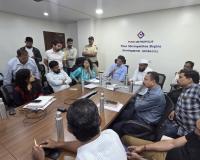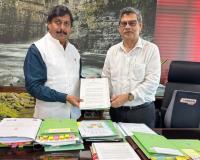- India
- Volcanic eruption in DR Congo: UNICEF working to restore water supply amid cholera threat |
Volcanic eruption in DR Congo: UNICEF working to restore water supply amid cholera threat |
The eruption of Mount Nyiragongo on 22 May melted mains water pipes and damaged a huge 5,000m³ reservoir, the agency said on Monday. Cholera fears Without access to safe water and sanitation, children and families are at heightened risk of waterborne diseases, such as cholera. “Cholera is particularly dangerous for the very young, the very old

The eruption of Mount Nyiragongo on 22 May melted mains water pipes and damaged a huge 5,000m³ reservoir, the agency said on Monday.
Cholera fears
Without access to safe water and sanitation, children and families are at heightened risk of waterborne diseases, such as cholera.
“Cholera is particularly dangerous for the very young, the very old and the undernourished, so an outbreak could have disastrous consequences for children,” said In Hye Sung, UNICEF emergency specialist.
“Children under age 5 have the highest incidence of cholera and are more likely to die from it, so it’s critical we ensure that families have access to safe water as soon as possible.”
Forced to flee
Thirty people were killed and some 3,500 others lost their homes due to the volcano eruption.
In the wake of the crisis, scores of people fled Goma for neighbouring towns, either because their homes were destroyed by lava or the authorities advised them to leave over fears of another eruption.
Together with domestic and international partners, UNICEF is working on the water issue, including through supporting the State-owned water company to redirect and protect a by-pass piping system that will send supply from the pumping station next to Lake Kivu, into part of the main water system.
As previous cholera epidemics in Goma started when residents collected dirty contaminated water for drinking, UNICEF has installed 15 emergency station chlorination points close to the lake.
Scaling up operations
The situation in Buhene, a district that was flattened by lava, illustrates the impact of the water shortages. Hundreds there had to queue for water provided from a truck hooked up to a pump, as a temporary measure.
UNICEF, along with humanitarian partners Caritas and AVUDS, was among the first agencies to truck water to tens of thousands of displaced people in the nearby towns of Sake, Rutshuru and Minova, and it is now doing the same in Goma.
The trucking operation has been ramped up, with the goal of providing emergency water supplies to some 200,000 people. It will be scaled down once the water network in Goma is partly functional again.
UNICEF is also part of a task force that is supporting installation of 1,500 meters of pipe on top of the lava to replace pipework that has melted. The pumping station will be reconnected to distribution reservoirs in the hills above Goma, which were not damaged during the eruption.













